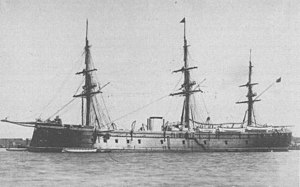 Numancia at anchor
| |
| History | |
|---|---|
| Name | Numancia |
| Namesake | Siege of Numantia |
| Builder | Forges et Chantiers de la Méditerranée, La Seyne, France |
| Laid down | 22 January 1861 |
| Launched | 19 November 1863 |
| Commissioned | 17 December 1864 |
| Refit | 1896–1898 |
| Stricken | 1912 |
| Fate | Sank while under tow, 17 December 1916 |
| General characteristics (as built) | |
| Type | Broadside ironclad |
| Displacement | 7,305 t (7,190 long tons) |
| Length | 95.6 m (313 ft 8 in) |
| Beam | 17.3 m (56 ft 9 in) |
| Draft | 7.7 m (25 ft) |
| Installed power | |
| Propulsion | 1 shaft, 1 horizontal-return connecting-rod steam engines |
| Sail plan | Ship rig |
| Speed | 12.7 knots (23.5 km/h; 14.6 mph) |
| Range | 3,000 nautical miles (5,600 km; 3,500 mi) at 10 knots (19 km/h; 12 mph) |
| Complement | 561 |
| Armament | 40 × 68-pounder (203 mm) smoothbore guns |
| Armor | |
The Spanish ironclad Numancia was an armored frigate bought from France during the 1860s for service with the Royal Spanish Navy (Armada Real). The name was derived from the Siege of Numantia, in which Roman expansion in the Iberian Peninsula was resisted. She was the first ironclad to circumnavigate the Earth. She saw service in the Chincha Islands War and Cantonal Revolution.[1]
- ^ Pastor y Fernandez de Checa, pp. 3–4